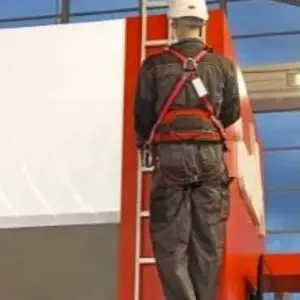Fall arresters are an important safety device, but how high do you need to be before one is required? The answer may surprise you!
What is a fall arrester?
A fall arrester, also commonly referred to as a personal fall protection system (PFAS), is a device that is used to arrest (or stop) a person who has fallen, or who is in danger of falling. This type of device is typically used in work environments where there is a potential for a worker to fall from an elevated height.
The device is attached to a worker’s body and to an anchor point, such as a building or scaffolding. If the worker falls, the fall arrester will stop their fall and prevent them from hitting the ground.
Fall arresters are typically used in conjunction with other forms of Personal Protective Equipment (PPE), such as harnesses, to provide complete protection for the user. When selecting a fall arrester, it is important to ensure that it is compatible with the other forms of PPE being used.
At what height is a fall arrester required?
There is no definitive answer to this question as fall arresters are required at different heights depending on the specific industry and job site. However, in general, fall arresters are typically required when working at heights of six feet or more. Additionally, fall arrest systems must be designed by a qualified professional and installed by a certified installer.
How high can a fall arrester be used effectively?
A fall arrester system can effectively protect workers who are at nearly any height above the ground or a platform. The only limitation to the height they can be used is the weight limit of the ropes and harness.
However, The fall arrestor must be positioned so that the fall will not exceed the length of the lanyard or webbing. In addition, the fall arrestor must be properly anchored to a secure point.
Fall arrestors can provide the last line of defense against serious injuries from falls. When used correctly, fall arrestors can help create a safe work environment and prevent accidents at a wide range of heights.
What are the different types of fall arresters?
There are numerous different types of fall arresters that can be used for a variety of different applications. The most common type of fall arrestor is the full-body harness, which is worn around the torso and legs and helps to distribute the force of a fall evenly around the body. Other types of fall arresters include chest and hip belts, lanyards, horizontal and vertical lifelines, netting, and rigid rail systems.
How does a fall arrester work?
A fall arrester is a device that is used to arrest, or stop, a person who is falling. Fall arresters work by distributing the force of the fall evenly around the worker’s body, which prevents serious injuries from occurring. In most cases, fall arresters will prevent the worker from falling more than a few feet before stopping them.
What are the benefits of using a fall arrester?
The use of fall arresters can provide significant benefits in terms of safety and security when working at height. They can help to prevent serious injuries or even fatalities in the event of a fall, and can also provide peace of mind for those working in potentially dangerous situations.
There are a number of different types of fall arresters available on the market, each designed for different purposes and applications. However, they all share the same basic principle of operation – they arrest the force of a fall, thereby preventing the user from hitting the ground.
In closing
Fall arrester systems are very effective when used properly, at nearly any height. Just make sure the one you wear is rated for your weight and the height you will be using it at.
NEXT UP: What Jobs Require a Fall Arrester?

